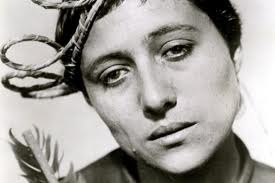OF LIGHT AND MUSIC AND PASSION
Voices of Light: The Passion of Joan of Arc
An Oratorio with Silent Film
Music by Richard Einhorn, film by Carl Theodor Dreyer
Baltimore Symphony Orchestra, UC Choral Ensembles and soloists
Conducted by Marin Alsop
Reviewed by Christopher Bernard
Carl Theodor Dreyer’s triumph of the terror and beauty of art, “The Passion of Joan of Arc,” a silent film premiered in 1928, and believed for two generations to be, in its original incarnation, lost, was voted by the curators of the Toronto International Film Festival two years ago as the most influential film ever made.
Cal Performances – founded when Sarah Bernhardt performed a benefit for the survivors of the 1906 earthquake, and since then one of the liveliest presenters of theater, music and dance groups in the United States – has once again risen to the occasion in bringing to UC’s Zellerbach Theater, for one performance, on March 31st, one of the musical and cinematic hallmarks of the last two decades: Richard Einhorn’s “oratorio with silent film,” “Visions of Light,” performed to a screening of that silent masterpiece now triumphantly restored thanks to the more mundane but no less impressive miracles of digital technology.
The film’s history is a drama in itself: based on the transcript of the trial for heresy by a court of English and Burgundians of the young shepherdess from Domremy whose visions of angelic voices (awakened by the tolling of the village bells as she sat at watch in the local pastures) led her to take up the sword to defend 15th century France against the invading English, it was made using many of the same technicians and even several actors as Abel Gance’s work of total cinema “Napoleon,” shot the year before (and which, coincidentally, was also screened with a full orchestra in the San Francisco Bay Area on the same weekend as “Joan,” creating a embarrassment of riches, and a paralyzing choice, for many a cinefile). It featured Renée Jeanne Falconetti in, in the opinions of many, one of the most searing acting performances ever committed to film (so searing for the actress that she vowed never to act in a film again – a vow that, unfortunately for us, she kept) and the young Antonin Artaud as her defender at trial.
Received with mixed reviews at the time (and suffering from the same historical turn that sent “Napoleon” into history’s deep-freeze for decades: the premiere of “The Jazz Singer,” which almost immediately made silent films seem obsolete, technology once again giving art an almost mortal wound), the film’s negatives and most of its prints were subsequently destroyed in a fire. Dreyer laboriously pieced together a print from outtakes and pieces of remaining prints, but the Danish director died thinking his original masterpiece had been lost. Then in 1981, long after the deaths of the film’s principals, a print was discovered in a janitor’s closet in (in a curious example of poetic justice) Denmark: a complete print, in almost pristine condition, with Danish intertitles, of the original film.
The experience of the film with Richard Einhorn’s music – an extraordinary act of loving creation and recreation – is of the highest intensity. The richly inspired oratorio was premiered at a now-legendary screening in 1994 and has been performed since more than 200 times, both with and without the film. Einhorn’s score is based largely on the modal scales of medieval music and the motivicly based repetitions of so-called “mystical minimalism” made popular by Henryk Gorecki and Arvo Pärt, with a text based on extracts from the Bible and writings of women writers and mystics of the time – from the redoubtable proto-feminist Christine de Pizan, who eulogized “La Pucelle” during Joan’s brief and glorious career, and the 10th century lyrics of Hildegard von Bingen, to more recondite texts by Umiltà da Faenza, Angela da Foligno, Marguerite d’Oingt and Na Prous Boneta (alternating with anti-female scurrilities from the patriarchs of the era), and including letters dictated by the illiterate Joan bearing news of her near-miraculous – and perhaps truly miraculous – military victories.
The experience of music and film together is of an amazing power and beauty, not least thanks to the forces performing under the inspired control of Marin Alsop, music director of the Baltimore Symphony Orchestra, which performed with equally magnificent singing from the UC Choral Forces. Not to be forgotten are the contributions by the soloists, of whom the quartet of sopranos and mezzo-sopranos – Elinor Broadman, Stacy Rutz, Genoa Starrs and Michelle Lee – must be singled out for their singular, and collective, magic.
Alsop has been taking “Visions of Light” on a world tour with the orchestra as part of the BSO’s season-long project featuring “revolutionary women.” At the head of that battalion the spirit of “la Pucelle” (a word often translated as “maid,” but meaning more a soul good and pure) bravely marches.
——————————————————————————————————–
Christopher Bernard is author of the novel A Spy in the Ruins and co-editor of Caveat Lector magazine (www.caveat-lector.org).

